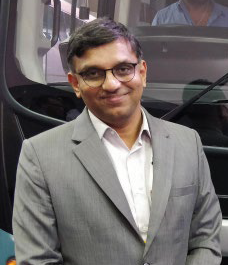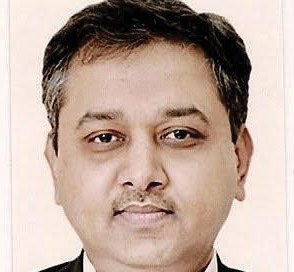The bus and coach segments are evolving rapidly courtesy of the push for green, digitalisation, and passenger comfort taking precedence, write Richa Tyagi and Upendra Kasbekar.
The bus and coach segments continue to evolve. Driven by environmental concerns, passenger expectations, and changes in urban mobility patterns, technology has advanced in line. The transition to alternative drivetrains including BEVs and gas-based options like LNG moving towards H2-ICE and FCEVs combined with a higher degree of safety for occupants and pedestrians alike, comfort, and digitalisation is driving innovations and new business models. These changes are not only reshaping how people travel but also re-imagining the future of public transport and intercity travel competing with other transportation modes.

VE Commercial Vehicles Ltd. has invested heavily in sustainability and green technologies, including CNG and electric vehicles. Suresh Chettiar, Executive Vice President – Bus Division, VE Commercial Vehicles Ltd emphasised, “We have already entered the emobility space in a significant way with our nine-metre buses, which are operating across different cities. As of now, we are enhancing the range of our EVs, and the first step is launching the 13.5m intercity coach. We will soon have a range of electric vehicles in the 12m segment for city applications, and this is part of our commitment to a sustainable future. He further stated, “The 13.5m coach for intercity commute applications, is a unique product that sets us apart in the country. We are the first to take that approach for intercity buses, and it’s once again a design with an extremely good fit and finish. This positions us in the value segment of intercity and EV travel.”
He informed, that the market in India has about 1.5 million buses, and the coaches and city buses form the most critical part. Operating city buses on the roads for almost six years now, the OEM is banking on coaches as the next big thing, ready to be unlocked. As a result, it is pushing forward, providing a whole ecosystem. Our vehicles have been operating for 10 to 12 years across the country,” stressed Nishant Arya, MD, JBM Group to make a case in point.

Anand S., Vice President of Tata Motors, demonstrated Tata Motors’ commitment to advancing the bus and coach segments as a full-range player. From nine-metre to intercity coach in the Magna. “We have launched the Magna EV coach for long-distance intercity travel, and this coach is an essential part of our efforts to meet the nation’s zero-emission goals,” Anand S mentioned.
Beyond electric buses, hydrogen fuel cell buses are emerging as another potential alternative. While still in the nascent stages, several companies are exploring this option as part of a broader effort to reduce greenhouse gas emissions. Anand S. revealed how the company is working on hydrogen fuel cell technology as well. “We have successfully deployed 15 hydrogen fuel cell buses for one of our customers, and we are closely monitoring and tracking the performance of these vehicles. It’s an exciting space, and we are investing in research and development to explore its full potential,” he informed. With CNG as part of the Tata portfolio for over 15 years, the company sits proudly with the expansion of its range to include the Ultra Prime CNG. “In addition to CNG, we have LNG as an option, which is becoming increasingly important as cities expand and the need for long-distance travel grows,” Anand S emphasised.
He also revealed that the company is exploring dual fuel options, with the Magic Bifuel as a case-in-point ( Flip the pages for an exclusive drive review of the Tata Magic Bi-fuel). The Magic is claimed to be an ideal solution for last-mile connectivity in urban environments with a promising 300 km range on a single fill of the 60-litre CNG twin tanks and the range extender five-litre petrol tank.
Front-engine multi-axle bus chassis
Ashok Leyland unveiled its pioneering Garud 15m coach chassis. The first front-engine multi-axle bus chassis is claimed to set a new industry standard. Designed specifically for long-distance intercity travel, this innovative platform offers the largest saloon space available in Indian buses. With a capacity of 42 sleeper berths, the Garud maximises per-trip revenue for bus operators. It boasts the highest GVW in its category at 22.5 tonnes (22,500 kg) and features a design for comfortable long-distance travel.

Additionally, it can accommodate a spacious luggage compartment, enhancing its functionality for extended journeys. Shenu Agarwal, MD & CEO, of Ashok Leyland, stated, “Ashok Leyland has consistently led the way in developing cost-effective technologies that benefit both customers and commuters. We are excited to unveil India’s first front-engine multi-axle bus chassis, designed to accommodate 42 sleeper berths. The Garud 15m represents a significant leap forward in bus chassis technology, combining advanced engineering with unparalleled comfort and efficiency.”
Ensuring both safety and comfort, the Garud chassis is equipped with a suite of advanced features such as front-wheel disc brakes, an electromagnetic retarder, and an optional full-air suspension with an anti-roll bar. The ergonomically designed three-way adjustable driver seat and the pneumatic-assist hydraulic clutch with a cable shift gear mechanism ensure a smooth and fatigue-free driving experience, on India’s diverse roads. Sanjeev Kumar, President – M&HCV at Ashok Leyland claimed, “We are not just enhancing our product portfolio but also setting new benchmarks in the intercity travel sector in India. This chassis is designed to meet the evolving needs of our customers and provides a superior travel experience for passengers.”
Government push
The transition to electric buses has been one of the most notable changes in the industry. Governments worldwide have been incentivising the shift, and several companies are answering the call by developing a range of electric bus models for city, intercity, and staff transportation.
Digitalisation and connected fleet
Another significant trend in the bus and coach industry is the digitalisation of operations. Connected buses equipped with advanced telematics, fleet management systems, and real-time tracking solutions are becoming the norm, enabling operators to optimise routes, monitor vehicle performance, and enhance passenger safety. Aditi Tracking has developed a GPS-based real-time fleet and asset monitoring system. This technology provides transparency that boosts operational efficiency and customer satisfaction. Aditi Tracking’s software seamlessly integrates with existing fleet management systems (FMS), offering users intuitive dashboards that display critical metrics at a glance. One of the company’s standout offerings is the “Cool Bus Solution,” a school bus tracking system designed to ensure the safety and convenience of students, parents, and school administrators. “By using GPS-enabled devices installed on buses, the Cool Bus Solution provides real-time location tracking, allowing parents to monitor bus movements and receive notifications on pickup and drop-off times,” said an Aditi Tracking spokesperson.
Passenger-centric technologies
In an industry that revolves around moving people, passenger comfort and convenience are paramount. Technology plays a crucial role in delivering better experiences, from online ticketing to in-cabin connectivity. Bitla Software, a prominent player in fleet operations, focuses on delivering software solutions that empower businesses such as tour and travel operators to streamline their processes. “Our ticketing platform, Ticket Simply, unites all Online Travel Agencies (OTAs) and creates a centralised online presence for bus operators,” explained A.R. Santosh, CEO of Bitla Software.
He continued, “Ticket Simply maximises conversion rates across various sales channels, whether operators sell tickets through their websites or third-party OTAs. We also provide a mobile app for bus crew members, allowing real-time coordination between the crew, dispatch manager, and field inspectors.” These innovations help operators manage sales, service, and marketing while enhancing passenger satisfaction. One logistics manager commented on the impact of Bitla’s software: “Since implementing Bitla’s platform, we have reduced delivery times by 20 per cent and cut down on fuel costs. It’s an invaluable asset for our operations.”

Safety Innovations
Safety is another critical area where technology is transforming the bus and coach industry. Advanced driver assistance systems (ADAS), driver monitoring systems, and accident prevention technologies are becoming standard in new buses, significantly reducing the likelihood of accidents caused by human error.
Anand also highlighted Tata Motors’ focus on last-mile connectivity, particularly in growing urban areas, where transport from metro stations to local neighbourhoods is crucial. “For long-distance travel, we have launched a 13.2-meter LPO 1822 chassis equipped with advanced comfort features, including front and rear air suspension, disc brakes, and Tata’s trusted engine with 925 Nm torque. This vehicle is also equipped with electromagnetic retarder braking, enhancing efficiency and safety, making it perfect for sleeper coaches.”

Satyajit Neogi, founder of Sapience Automata, shared insights into his company’s efforts to build accident prevention systems tailored for India. “We are building products in India, primarily driver assistance systems and driver monitoring systems, aimed at preventing accidents. Our core driver camera system sends live in-cabin alerts for drowsiness, distraction, or fatigue and provides a mobile app for fleet owners to monitor driver performance.” Neogi highlighted that the company’s mission is to reduce road accidents in India. “Our goal is to prevent up to 90 per cent of road accidents by installing our system in fleets. We’ve worked with over 200 drivers to ensure that our system optimises the driving experience without overwhelming the driver with unnecessary features.”
Tata Ficosa’s Camera Monitoring System (CMS) is also addressing one of the most pressing safety concerns in the automotive sector. The CMS replaces traditional mirrors with HD cameras that provide a wider field of view, eliminating blind spots that often lead to accidents. The system’s user-friendly interface displays real-time video feeds to the driver, ensuring that they have a comprehensive view of their surroundings. This enhancement not only improves safety but also increases driver confidence, in challenging driving conditions.
Design and comfort
VE Commercial Vehicles Ltd. is driving innovation in the bus industry by blending cutting-edge design, sustainability, and premium comfort across its product range. Chettiar emphasised the company’s commitment to sustainability while enhancing the passenger experience. “We are unveiling our Skyline Pro school bus, which features innovations like automatic mechanical transmission and air conditioning, all wrapped in a completely new design. This bus brings a range of features aimed at ensuring a high-quality commuting experience for school children.”
Highlighting their leadership in the market, Chettiar added, “We are the first in the country to introduce an intercity bus of this length, marked by outstanding design, superior fit and finish. This positions us strongly in the value segment of both intercity and EV travel. On the Volvo front, we are once again raising the standard by introducing world-class interiors in our sleeper buses. Developing these interiors requires immense effort and precision to create an environment that stands among the best in the world. We’re incredibly proud of this accomplishment.” He also noted the company’s dedication to providing a wide array of transport solutions: “Across all product segments, from value to premium, we are continuously expanding our portfolio with unique offerings. Our investments align with India’s green mobility goals, and we have scaled our capacity to meet the growing demand for efficient, sustainable public transport solutions.” “We have ultra-luxury coaches for our customers in India. As we have been deploying intercity buses across the country, the ultraluxury category will definitely add value for our customers. We have signed multiple contracts with different operators and funding companies that are looking to invest in this space heavily,” concluded Nishant.





















